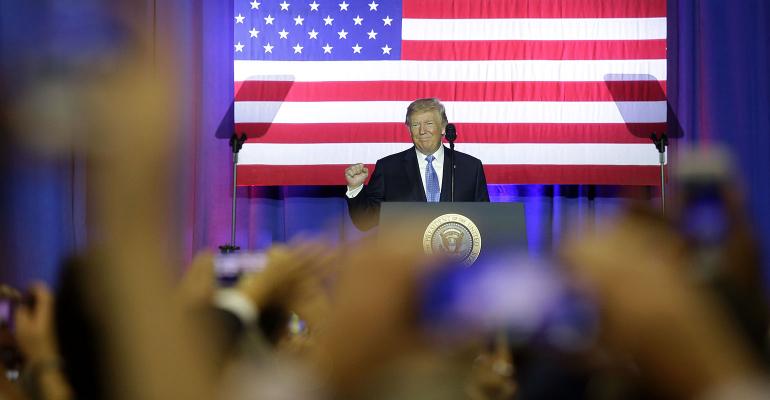By Robert Burgess
President Donald Trump likes to equate the rally in stocks since the November 2016 elections with confidence in him and his policies. And yes, the S&P 500 Index has surged 22 percent since then, but a deeper look at equities, bonds and the dollar reveals anything but trust in his stewardship.
Here's the executive summary: U.S. companies are valued less now than before Trump was elected, despite the run-up in stocks, big corporate tax cuts, reductions in regulations and booming earnings. The cost to borrow for the U.S. has soared relative to other governments, a sign investors are worried about America's creditworthiness. The dollar's share of global currency reserves has dropped by the most since 2002.
Investors are losing faith because Trump is turning into the type of president many always feared: unpredictable, volatile and tempestuous. Those characteristics were certainly present last year, but they were largely overlooked as his administration pushed through pro-growth, pro-business initiatives such as tax reform and regulatory cuts. Now, many highly-regarded White House staffers such as former Goldman Sachs President Gary Cohn and cabinet members such as former Exxon Mobil Chief Executive Rex Tillerson have exited and it's unclear who is left to keep Trump in check on his more radical policies such as those he is pushing through now on trade.
For a growing number of global money managers, the risks of investing in the U.S. are too great right now given the political uncertainty. “At some point, you just bite the bullet and say, I’m just going to get out of all my assets, all my exposures out of the U.S.,” Nader Naeimi, a money manager at the $145 billion AMP Capital Investors in Sydney, told Bloomberg News. “That’s the No. 1 thing we’re thinking.”
Let's start with stocks. The S&P 500 has fallen 9.34 percent from its peak on Jan. 26, in part over worries about the fallout from a potential trade war between the U.S. and China. The sell-off means that even though stocks are up overall since the elections and the inauguration, the S&P 500 is trading at about 16 times projected earnings, down from 18.5 in January and the lowest since mid-2016. This comes even though analysts expect companies to report that first-quarter earnings surged 17 percent from a year earlier. It's rare to see such a contraction in multiples with profits rising at such a fast pace.

Of course, stock valuations worldwide have diminished, but few have shrunk like those in the U.S. At the end of last year, the price-to-expected-earnings ratio for the S&P 500 was 3.5 levels higher than the Stoxx Europe 600. By last week, that gap had narrowed to two levels.
The bond market is worried the federal budget deficit will grow to unsustainable levels because of the revenue lost from the tax cuts. The Treasury Department said it plans to more than double debt sales this year to $1 trillion to make up for the shortfall. Already under Trump, total public debt outstanding has surged to $21.1 trillion from $19.8 trillion as recently as of September.
Demand at the government's debt auctions is down; investors placed $2.75 in bids for every $1 of debt offered by the government, the fewest since 2009. On average, the Treasury Department pays 2 percentage points more in yield than other governments, according to ICE Bank of America Merrill Lynch bond indexes. As recently as 2011, it cost the U.S. 1.18 percentage points less to borrow relative to the rest of the world.

Sure, many variables get factored into bond yields, including relative monetary policies, inflation and economic growth rates. And in the U.S., interest rates put in place by the Federal Reserve are much higher than just about everywhere else. But even when stripping short-term debt out of the equation and focusing on longer-term maturities that are less influenced by monetary policy and align more closely with things like investor perception of creditworthiness, the U.S. is still paying a hefty rate. On debt with maturities of 10 years or longer, the premium paid by the U.S. is also about 2 percentage points, the most since 2000.
It's said that a nation's currency is not much different than a company's share price in that it's probably the best indicator of investor sentiment. If so, the U.S. is in big trouble. The Bloomberg Dollar Spot Index, which measures the currency against its major market peers, fell 8.52 percent last year. In February, it touched its lowest since late 2014. This is also a remarkable move because a currency typically appreciates as interest rates rise.
It would be easy to dismiss the greenback's weakness as just the ebb and flow of exchange rates, until you consider that the International Monetary Fund just said that the dollar's share of global foreign-exchange reserves fell 2.64 percentage points last year, the most since 2002. At 62.7 percent, the dollar's overall share of reserves, while still much higher than the euro's 20.1 percent, is the lowest since 2013.

Trump was largely elected by frustrated Americans who wanted a president who could disrupt the status quo and bring some fresh ideas to Washington. Trump has certainly done that, but the markets are signaling that he risks going too far. Markets are fine with disruptors. Not so much with anarchists.
Bloomberg Prophets
Professionals offering actionable insights on markets, the economy and monetary policy. Contributors may have a stake in the areas they write about.
To contact the author of this story:
Robert Burgess at [email protected]
To contact the editor responsible for this story:
Max Berley at [email protected]





